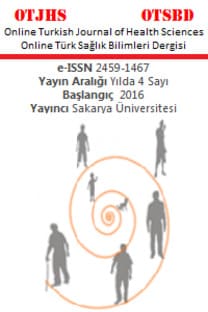Endometrial Hiperplazi ve Karsinomunda Nükleus Boyutunun Karşılaştırmalı Morfometrik Analizi
endometrial hiperplazi, morfometrik analiz, endometrial intraepitelyal neoplazi
Comparative Morphometric Analysis of Nucleus Size in Endometrial Hyperplasia and Carcinoma
___
- Ferlay J, Soerjomataram I, Ervik M, et al. GLOBOCAN 2012 v1. 0, Cancer incidence and mortality worldwide: IARC Cancer Base No. 11. Lyon, France: International Agency For Research On Cancer. 2012;11. doi:10.1002/ijc.29210
- Siegel R, Ma J, Zou Z, Jemal A. Cancer statistics. Cancer Journal For Clinicians. 2018;68(5):329-339. doi: 10.3322/caac.21208
- Kurman RJ, Kaminsk PF, Norris HJ. The behavior of endometrial hyperplasia. A long‐term study of “untreated” hyperplasia in 170 patients. Cancer. 1985;56(2):403-412.
- Emons G, Beckmann MW, Schmidt D, Mallmann P. Uterus commission of the Gynecological Oncology Working Group (AGO). New WHO Classification of Endometrial Hyperplasias. Geburtshilfe Frauenheilkd. 2015;75(2):135-136. doi:10.1055/s-0034-1396256
- Collan Y. Diagnostic morphometry: Relevant background to decision making in diagnostic histopathology Science on Form: Proceedings of the First International Symposium for Science on Form. KTK Scientific Publishers, Tokyo. 1986;533-542.
- Sørensen FB. Quantitative analysis of nuclear size for prognosis-related malignancy grading. Advances in Oncobiology. 1996;1:221-255. doi :10.1016/S1569-254X(96)80013-6
- Pell R, Oien K, Robinson M, et al. The use of digital pathology and image analysis in clinical trials. Journal of Pathological Clinical Research. 2019;5:81-90. doi:10.1002/cjp2.127
- Nunes T, Filippi-Chiela E, Callegari-Jacques S, et al. Nuclear morphometric analysis in tissue as an objective tool with potential use to improve melanoma staging. Melanoma Research. 2019;29(5):474-482 doi: 10.1097/CMR.0000000000000594
- Yang W, Tian R, Xue T. Nuclear shape descriptors by automated morphometry may distinguish aggressive variants of squamous cell carcinoma from relatively benign skin proliferative lesions: a pilot study. Tumour Biology. 2015;36:6125–6131. doi: 10.1007/s13277-015-3294-5
- Hoque A, Lippman SM, Boiko IV, et al. Quantitative nuclear morphometry by image analysis for prediction of recurrence of ductal carcinoma in situ of the breast. Cancer Epidemiology, Biomarkers&Prevention. 2001;10:249–259.
- Vukovic LD, Jevtic P, Edens LJ, Levy DL. New insights into mechanisms and functions of nuclear size regulation. International Review of Cell and Molecular Biology. 2016;322:1–59. doi: 10.1016/bs.ircmb.2015.11.001
- Downing MJ, Papke DJ, Tyek S, Mutter GL. A New Classification of Benign, Premalignant, and Malignant Endometrial Tissues Using Machine Learning Applied to 1413 Candidate Variables. International Journal of Gynecological Pathology. 2020;39(4):333-343. doi: 10.1097/PGP.0000000000000615
- Malpica A, Michael TD, Euscher E. Biopsy interpretation of the uterine cervix and corpus. 1nd edition Lippincott Williams & Wilkins, 2009;177.
- Skaarland E, Nuclear size and shape of epithelial cells from the endometrium: lack of value as a criterion for differentiation between normal, hyperplastic, and malignant conditions. Journal of Clinical Pathology. 1985;38(5):502-506. doi: 10.1136/jcp.38.5.502
- Baak JP, Nauta, JJP, Wisse‐Brekelmans ECM, Bezemer PD. Architectural and nuclear morphometrical features together are more important prognosticators in endometrial hyperplasias than nuclear morphometrical features alone. The Journal of Pathology. 1988;154(4):335-341. doi: 10.1002/path.1711540409
- Dunton CJ, Baak JP, Palazzo JP, van Diest PJ, McHugh M, Widra EA. Use of computerized morphometric analyses of endometrial hyperplasias in the prediction of coexistent cancer. American Journal Of Obstetrics And Gynecology. 1996;174(5):1518-1521. doi: 10.1016/s0002-9378(96)70599-9
- Mahovlić V, Ovanin RA, Škopljanac ML, et al. Digital morphometry of cytologic aspirate endometrial samples. Collegium Antropologicum. 2010;34(1):45-51.
- Toy H, Etli O, Celik ZE, Alikanoglu AS. Associations between nucleus size, and immunohistochemical Galectin-3, Cytokeratine-19 and Hbme-1 markers in thyroid papillary carcinoma: a morphometric analyze. Pathology & Oncology Research. 2019;25(1):401-408.
- Deans GT, Hamilton PW, Watt PCH, et al. Morphometric analysis of colorectal cancer. Diseases of the Colon & Rectum. 1993;36:450–456. doi: 10.1007/BF02050010
- Celik ZE, Altinay S, Kilinc F, et al. Using Computerized Cytomorphometry to Distinguish between Benign and Malignant Cases in Thyroid Fine‐Needle Aspiration Cytology. Diagn. Cytopathol. 2016;44:902-911. doi:10.1002/dc.23611
- ISSN: 2459-1467
- Yayın Aralığı: Yılda 4 Sayı
- Başlangıç: 2016
- Yayıncı: Oğuz KARABAY
Riskli Gebelerde Prenatal Bağlanma ve Risklerin Değerlendirilmesi
Ayça DEMİR YILDIRIM, Nevin ŞAHİN
Mustafa BÜYÜKAVCI, Mehmet Fatih ORHAN, Olena ERKUN, Ayşegül PALA
Youtube ve Astım: Astımla İlgili Popüler Videoların Bilgi İçeriğinin Eleştirel Bir Değerlendirmesi
Fatma Esra GÜNAYDIN, Sedat ALTIN
Evde Sağlık Hizmetlerinde İnformal Bakım Verenlerin Bilgi ve Beceri Düzeyinin Belirlenmesi
Özden GÜDÜK, Özlem GÜDÜK, Yaşar SERTBAŞ
COVID-19 Pozitif Hastaya Hemşirelik Bakımı Veren Bir Hemşirenin Deneyimleri: Olgu Sunumu
Canan BİRİMOĞLU OKUYAN, Elifnur GÜNEŞ, Esra YEŞİLYURT
Ortodontiye İlişkin Dünya Genelindeki İnternet Verilerinin Değerlendirilmesi: Google Trends Analizi
Muhammed Hilmi BÜYÜKÇAVUŞ, Burak KALE, Hikmet ORHAN
Beyin Ölümü Tanısı Alan Hastaların Retrospektif Analizi
Endometrial Hiperplazi ve Karsinomunda Nükleus Boyutunun Karşılaştırmalı Morfometrik Analizi
